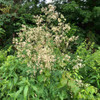Thalictrum dasycarpum - PURPLE MEADOW RUE
Upright narrower perennial with smaller compound leaves, purple-red stems and clusters of cream white flowers. This meadow rue grows in female and male individuals (with female or male flowers). Male flowers are usually bigger and more showy, making a good cut flower. The best use is in half-shade flower beds, close to water features, in wildflower gardens, medium moist meadows, moist woodland edges or naturalized areas. Good background plant in the perennial border. It is tolerant to black walnuts.
Good perennial companions can be Aster, Baptisia, Boltonia, Chelone, Eupatorium fistulosum and E. purpureum, Filipendula rubra, Monarda didyma, Parthenium inegrifolium, Phlox paniculata, Physostegia, Rudbeckia fulgida, Rudbeckia subtomentosa, Rudbeckia maxima, Tradescantia, Veronicastrum and grasses.
Picture copyright : US Perennials
Blooming Time: May/June to July
Size: up to 5’ tall x 3’ wide
USDA Zones: 4 to 7
Culture: full sun (will require regular/constant moisture), half sun, half shade, dappled shade, good loamy soils with some rock or sand, loam; should grow fine in average garden soil
Moisture Needs: medium, medium-moist, moist
Origin: native wildflower to most states of the USA except California, Nevada, Oregon and those on the east coast. Grows naturally in river-bottom prairies, savannas, thickets, woodland borders, openings in wooded areas, floodplain woodlands, swamps etc.
Deer/Rabbit Resistant: partially / yes (white tailed deer may occasionally browse on it)
Attracts Butterflies or Pollinators: honey bees and native bees are occasionally attracted to the male flower. Host plant of caterpillars of several species of moths.
Attracts Hummingbirds: no
Pot Size: 3.5" x 4" perennial pot (1.22 pt/580 ml)

Thalictrum dasycarpum - PURPLE MEADOW RUE
Upright narrower perennial with smaller compound leaves, purple-red stems and clusters of cream white flowers. This meadow rue grows in female and male individuals (with female or male flowers). Male flowers are usually bigger and more showy, making a good cut flower. The best use is in half-shade flower beds, close to water features, in wildflower gardens, medium moist meadows, moist woodland edges or naturalized areas. Good background plant in the perennial border. It is tolerant to black walnuts.
Good perennial companions can be Aster, Baptisia, Boltonia, Chelone, Eupatorium fistulosum and E. purpureum, Filipendula rubra, Monarda didyma, Parthenium inegrifolium, Phlox paniculata, Physostegia, Rudbeckia fulgida, Rudbeckia subtomentosa, Rudbeckia maxima, Tradescantia, Veronicastrum and grasses.
Picture copyright : US Perennials
Blooming Time: May/June to July
Size: up to 5’ tall x 3’ wide
USDA Zones: 4 to 7
Culture: full sun (will require regular/constant moisture), half sun, half shade, dappled shade, good loamy soils with some rock or sand, loam; should grow fine in average garden soil
Moisture Needs: medium, medium-moist, moist
Origin: native wildflower to most states of the USA except California, Nevada, Oregon and those on the east coast. Grows naturally in river-bottom prairies, savannas, thickets, woodland borders, openings in wooded areas, floodplain woodlands, swamps etc.
Deer/Rabbit Resistant: partially / yes (white tailed deer may occasionally browse on it)
Attracts Butterflies or Pollinators: honey bees and native bees are occasionally attracted to the male flower. Host plant of caterpillars of several species of moths.
Attracts Hummingbirds: no
Pot Size: 3.5" x 4" perennial pot (1.22 pt/580 ml)




